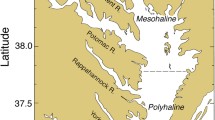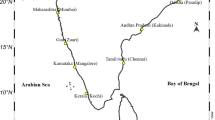Abstract
The extraction of climatic signals from time series of biogeochemical data is further complicated in estuarine regions because of the dynamic interaction of land, ocean, and atmosphere. We explored the behavior of potential global and regional climatic stressors to isolate specific shifts or trends, which could have a forcing role on the behavior of biogeochemical descriptors of water quality and phytoplankton biomass from Florida Bay, as an example of a sub-tropical estuary. We performed statistical analysis and subdivided the bay into six zones having unique biogeochemical characteristics. Significant shifts in the drivers were identified in all the chlorophyll a time series. Chlorophyll a concentrations closely follow global forcing and display a generalized declining trend on which seasonal oscillations are superimposed, and it is only interrupted by events of sudden increase triggered by storms which are followed by a relatively rapid return to pre-event conditions trailing again the long-term trend.






Similar content being viewed by others
References
Adrian, R., S. Wilhem, and D. Gerten. 2006. Life-history traits of lake plankton species may govern their phenological response to climate warming. Global Change Biology 12: 652–661.
Belgrano, A., M. Lima, and N.C. Stenseth. 2004. Non-linear dynamics in marine phytoplankton population systems. Marine Ecology Progress Series 273: 281–289.
Box, G., G. Jenkins, and G. Reinsel. 1994. Time-series analysis: Forecasting & control. New Jersey: Prentice Hall.
Boyer, J.N., and H.O. Briceño. 2007. South Florida Coastal Water Quality Monitoring Network. FY2006 Cumulative Report South Florida Water Management District, Southeast Environmental Research Center, Florida International University (http://serc.fiu.edu/wqmnetwork/).
Boyer, J.N., J.W. Fourqurean, and R.D. Jones. 1997. Spatial characterization of water quality in Florida Bay and Whitewater Bay by principal component and cluster analyses: Zones of similar influence (ZSI). Estuaries 20: 743–758.
Boyer, J.N., J.W. Fourqurean, and R.D. Jones. 1999. Seasonal and long-term trends in water quality of Florida Bay (1989–97). Estuaries 22: 417–430.
Brand, L. 2001. The transport of terrestrial nutrients to South Florida coastal waters. In The Everglades, Florida Bay, and Coral Reefs of the Florida Keys, ed. J.W. Porter and K.G. Porter, 361–414. Boca Raton: CRC.
Chatfield, C. 1996. The analysis of time-series, 5th ed. London: Chapman & Hall.
Cosby, B., W. Nuttle, and F. Marshall. 2005. FATHOM enhancements and implementation to support development of minimum flows and levels for Florida Bay. South Florida Water Management District Contract C-C-15975-WO05-05 Final Report. Environmental Consulting & Technology, Inc. 168 p.
Davis, S.E., J.E. Cable, D.L. Childers, C. Coronado-Molina, J.W. Day, C. Hittle, C.J. Madden, E. Reyes, D.T. Rudnick, and F.H. Sklar. 2004. Importance of storm events in controlling ecosystem structure and function in a Florida Gulf coast estuary. Journal of Coastal Research 20: 1180–1208.
Delworth, T.L. and M.E. Mann. 2000. Observed and simulated multidecadal variability in the Northern Hemisphere. Climate Dynamics 16: 661–676.
Duncan, A.J. 1974. Quality control and industrial statistics. Homewood: Richard D. Irwin.
Emery, W.J. and R.E. Thomson. 2001. Data analysis methods in physical oceanography, 2nd ed. San Diego: Elsevier.
Enfield, D.B., A.M. Mestas-Nuñez, and P.J. Trimble. 2001. The Atlantic multidecadal oscillation and its relation to rainfall and river flows in the continental U.S. Geophysical Research Letters 10(28): 2077–2080.
Ewan, W.D. 1963. When and how to use Cu-sum charts. Technometrics 5: 1–32.
Fourqurean, J.W. and M. Robblee. 1999. Florida Bay: a history of recent ecological changes. Estuaries 22: 345–357.
Fourqurean, J.W., R.D. Jones, and J.C. Zieman. 1993. Processes influencing water column nutrient characteristics and phosphorus limitation of phytoplankton biomass in Florida Bay, FL, USA: Inferences from spatial distributions. Estuarine, Coastal and Shelf Science 36: 295–314.
Fourqurean, J.W., J.N. Boyer, M.J. Durako, L.N. Hefty, and B.J. Peterson. 2003. Forecasting responses of seagrass distributions to changing water quality using monitoring data. Ecological Applications 13: 474–489.
Goldenberg, S., C.W. Landsea, A.M. Mestas-Nunez, and W.M. Gray. 2001. The recent increase in Atlantic hurricane activity: Causes and implications. Science 293: 474–479.
Grant, E.L. and R.S. Leavenworth. 1980. Statistical quality control, 5th ed. New York: McGraw-Hill.
Hinkley, D.V. 1971. Inference about the change-point from cumulative sum tests. Biometrika 5: 509–523.
Hinkley, D. and E. Schechtman. 1987. Conditional bootstrap methods in the mean-shift model. Biometrika 74: 85–93.
Hitchcock, G.E. Phlips, E.J., Brand, L., Morrison, D., 2007. Plankton Blooms. In: Hunt, J.H., Nuttle, W. (Eds.), Florida Bay Science Program: A Synthesis of Research on Florida Bay. Fish and Wildlife Research Institute Technical Report TR-1
Hunt, J.H. and W. Nuttle. 2007. Florida Bay Science Program: A Synthesis of Research on Florida Bay. Fish and Wildlife Research Institute Technical Report TR-11.
Hurrell, J.W. 1995. Decadal trends in the North Atlantic Oscillation: Regional temperatures and precipitation. Science 269: 676–679.
Ibanez, F., J.M. Fromentin, and J. Castel. 1993. Application of the cumulated function to the processing of chronological data in oceanography. Comptes rendus de l’Acade´mie des Sciences, Serie 3(318): 745–748.
Johnson, N.L. 1961. A simple theoretical approach to cumulative sum control charts. Journal of the American Statistical Association 56: 83–92.
Kerr, R.A. 2000. A North Atlantic climate pacemaker for the centuries. Science 288: 1984–1986.
Landsea, C.W., N. Nicholls, W.M. Gray, and L.A. Avila. 1996. Downward trends in the frequency of intense Atlantic hurricanes during the past five decades. Geophysical Research Letters 23: 1697–1700.
Manly, B.F.J. and D. MacKenzie. 2000. A cumulative sum type of method for environmental monitoring. Environmetrics 11: 151–166.
Manson, R. and D. Lind. 1996. Statistical techniques in business and economics, 9th ed. New York: Irwin-McGraw-Hill.
Molinero, J.C., F. Ibanez, S. Souissi, E. Buecher, S. Dallot, and P. Nival. 2008. Climate control on the long-term anomalous changes of zooplankton communities in the Northwestern Mediterranean. Global Change Biology 14: 11–26.
Nuttle, W., J.W. Fourqurean, B.J. Cosby, J. Zieman, and M. Robblee. 2000. Influence of net freshwater supply on salinity in Florida Bay. Water Resources Research 36: 1805–1822.
Phlips, E.J. and S. Badylak. 1996. Spatial distribution and composition of algal blooms in Florida Bay. Bulletin Marine Science 58(1): 203–216.
Phlips, E.J., S. Badylak, and T. Lynch. 1999. Blooms of the picoplanktonic cyanobacterium Synechococcus in Florida Bay, a subtropical inner-shelf lagoon. Limnology and Oceanography 44: 1166–1175.
Robblee, M.B., T.B. Barber, P.R. Carlson Jr., M.J. Durako, J.W. Fourqurean, L.M. Muehlstein, D. Porter, L.A. Yarbro, R.T. Zieman, and J.C. Zieman. 1991. Mass mortality of the tropical seagrass Thalassia testudinum in Florida Bay (U.S.A). Marine Ecology Progress Series 71: 297–299.
Rudnick, D., C. Madden, S. Kelley, R. Bennett, and K. Cunniff. 2006. Report on algae Blooms in Eastern Florida Bay and Southern Biscayne Bay. Report: SFWMD Tech.
Schomer, N.S., and R.D. Drew. 1982. An ecological characterization of the lower Everglades, Florida Bay and the Florida Keys. FWS/OBS-82/58.1. US Fish and Wildlife Service, Office of Biological Services, Washington, D. C.
Steele, J.H. and E.W. Henderson. 1981. A simple plankton model. American Naturalist 117: 676–691.
Sturges, W. 1983. On interpolating gappy records for time-series analysis. Journal of Geophysical Research 88: 9736–9740.
Taylor, W. (2000a). Change-Point Analyzer 2.0 shareware program, Taylor Enterprises, Libertyville, Illinois. Web: http://www.variation.com/cpa
Taylor, A., J. Allen, and P. Clark. 2002. Extraction of a weak climatic signal by an ecosystem. Nature 416: 629–632.
Tomas, C.R., B. Bendis, and K. Johns. 1999. Role of nutrients in regulating plankton blooms in Florida Bay. In The Gulf of Mexico large marine ecosystem: Assessment, sustainability, and management, ed. H. Kumpf, K. Steidenger, and K. Sherman, 323–337. Malden: Blackwell Science.
Zieman, J.C., J.W. Fourqurean, and R.L. Iverson. 1989. Distribution, abundance and productivity of seagrasses and macroalgae in Florida Bay. Bulletin of Marine Science 44(1): 292–311.
Wang, J., J. Van De Kreeke, N. Krishnan, and D. Smith. 1994. Wind and tide response in Florida Bay. Bulletin of Marine Science 54: 579–601.
Williams, C., J.N. Boyer, and F. Jochem. 2008. Indirect hurricane effects on resource availability and microbial communities in a subtropical wetland-estuary transition zone. Estuaries and Coasts 31: 204–214.
Woodall, W.H. and B.M. Adams. 1993. The Statistical Design of CUSUM Charts. Quality Engineering 5: 559–570.
Further Reading
Boyer, J.N. 2004. The value of a regional water quality monitoring network in restoration planning in South Florida. EMAP Symposium, May 6, 2004—Newport, RI.
Briceño, H. and A. Callejon. 2000. Chemostratigraphic correlation of the Source Rock in the La Luna K-T(!) Petroleum System in Southwestern Venezuela. In Paleogeography and hydrocarbon potential of La Luna Formation and related Cretaceous anoxic systems, Proceedings SEPM Research Conference 2000, Venezuela
Rudnick, D., C. Madden, S. Kelly, J. Boyer, S. Blair, K. Cunniff, and C. Kelble. 2007. Disturbance and ecosystem change in Florida Bay and Southern Biscayne Bay. Providence: Estuarine Research Federation Conference.
Steidinger, K., W. Richardson, M.B. Neely, G. McRae, S. Richards, R. Bray, T.H. Perkins, and C.R. Tomas. 2001. Florida Bay microalgal blooms. 2001 Florida Bay Science Conference, Key Largo, Florida USA.(Abstract)
Acknowledgments
This research was funded by the National Science Foundation through the Florida Coastal Everglades Long-Term Ecological Research Program (DEB-9901514). And by South Florida Water Management District (contract #4600000352). We especially thank Ed Phlips for comments on an earlier version of the manuscript. Data are available at serc.fiu.edu/wqmnetwork/. This is contribution No. 428 of the Southeast Environmental Research Center at Florida International University.
Author information
Authors and Affiliations
Corresponding author
Rights and permissions
About this article
Cite this article
Briceño, H.O., Boyer, J.N. Climatic Controls on Phytoplankton Biomass in a Sub-tropical Estuary, Florida Bay, USA. Estuaries and Coasts 33, 541–553 (2010). https://doi.org/10.1007/s12237-009-9189-1
Received:
Revised:
Accepted:
Published:
Issue Date:
DOI: https://doi.org/10.1007/s12237-009-9189-1




